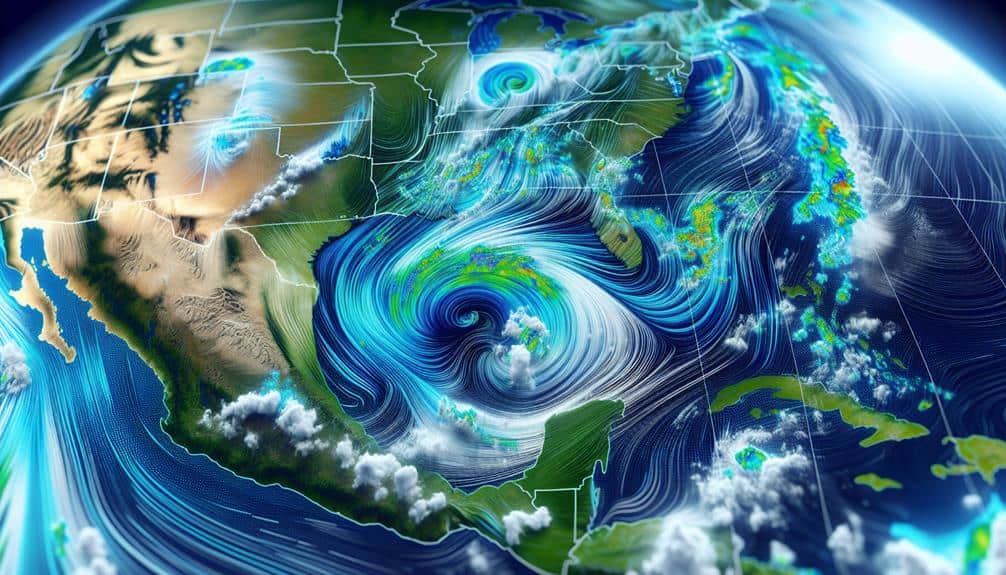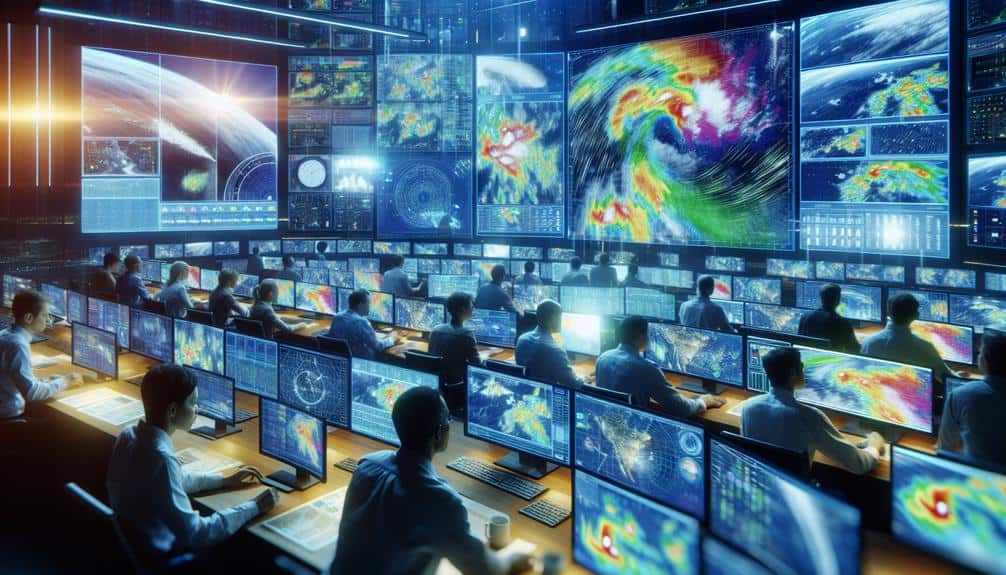We base our storm formation predictions on multiple accurate meteorological factors. Atmospheric pressure changes, particularly drops, signal pending storms. Temperature variations, especially at the surface, create the necessary instability. High humidity supports cumulonimbus cloud formation and fuels latent heat. Wind patterns, including jet stream tracking and wind shear, affect storm paths and growth. Cloud formation, driven by adiabatic cooling, plays a critical role. Real-time satellite data enhances our forecasts with high-resolution imagery and remote-sensing technologies. Understanding these interconnected factors allows us to predict storm formations with greater accuracy, improving early warnings and mitigation strategies. Dive deeper to grasp these dynamics fully.
Key Points
- Atmospheric pressure changes, especially rapid drops, signal the approach of storms.
- High humidity levels contribute to cloud formation and storm development.
- Temperature variations and differential heating create atmospheric instability crucial for storm formation.
- Wind patterns and wind shear significantly influence storm growth and trajectory.
Atmospheric Pressure
Atmospheric pressure, which we measure in units such as millibars or inches of mercury, plays a pivotal role in the development and prediction of storm formations. When we analyze pressure systems, we're basically looking at areas of high and low atmospheric pressure. Low-pressure systems, characterized by rising air, are often associated with stormy weather conditions. Conversely, high-pressure systems, where air descends, usually bring about clearer skies.
To enhance our forecasting accuracy, we utilize data from barometric readings, satellite observations, and weather models. By identifying shifts in atmospheric pressure, we can predict the formation and intensity of storms with greater precision. For example, a rapid drop in atmospheric pressure typically signals the approach of a storm, allowing us to issue timely warnings.
Our ability to map these pressure systems in real-time is essential for meteorologists. It empowers us to make informed decisions that can save lives and property. By understanding the dynamics of pressure systems, we're not just predicting weather; we're offering the freedom to prepare and respond effectively.
Essentially, atmospheric pressure serves as a foundational element in the science of storm prediction.
Temperature Variations
Let's examine how variations in surface temperature influence storm formation.
We observe that differential heating impacts atmospheric heat distribution, creating regions of instability.
This thermal gradient is a critical factor in the development and intensity of storm systems.
Surface Temperature Impact
Surface temperature variations greatly influence storm formation by altering atmospheric pressure gradients and moisture content. When we examine the intricate dynamics of storm genesis, it's evident that heat absorption by the Earth's surface plays a pivotal role.
Warmer surfaces, particularly oceanic regions, enhance the process of evaporation, subsequently increasing atmospheric moisture levels. This added moisture feeds storm systems, providing them with the necessary energy to intensify.
Climate change exacerbates these temperature variations, leading to more frequent and severe storm events. As global temperatures rise, the heat absorption capacity of land and sea surfaces changes, creating more pronounced thermal gradients. These gradients drive stronger pressure differentials, ultimately resulting in more dynamic and volatile atmospheric conditions.
We observe that regions experiencing higher rates of warming are becoming hotspots for intense storm activity. The correlation between surface temperature variations and storm formation underscores the importance of precise temperature monitoring.
Atmospheric Heat Distribution
Understanding how heat is distributed through the atmosphere is essential for predicting storm formations and their potential intensities. We must examine the mechanisms of heat transfer—conduction, convection, and radiation—to comprehend the dynamic processes at play.
Conduction involves direct heat transfer between molecules, mainly influencing surface temperatures. Convection, driven by temperature gradients, circulates heat vertically and horizontally, significantly impacting atmospheric stability and storm development.
Radiation, particularly from solar insolation, varies with latitude and season, creating differential heating that fuels atmospheric circulation patterns. These patterns, in turn, influence moisture distribution and cloud formation, critical factors in storm genesis.
Global warming exacerbates these processes by increasing the overall energy within the system. Elevated sea surface temperatures enhance evaporation rates, leading to more water vapor in the atmosphere. This additional moisture intensifies convective activity, potentially resulting in more frequent and severe storms.
Our predictive models must integrate these thermal dynamics to improve accuracy. By understanding the precise roles of heat transfer and the amplifying effects of global warming, we empower ourselves to forecast storm behaviors more reliably.
This knowledge not only aids in better preparedness but also supports our drive for greater autonomy in mitigating natural disaster impacts.
Humidity Levels

Let's examine how humidity levels influence storm genesis by focusing on the measurement of atmospheric moisture and its impact on weather patterns.
By quantifying relative humidity and dew point, we can assess the potential for storm development.
Higher humidity levels contribute to the formation of cumulonimbus clouds, which are precursors to severe weather events.
Role in Storm Genesis
Humidity levels play a vital role in storm genesis by providing the necessary moisture for cloud formation and convective processes. When we analyze storm tracking data, we observe that higher humidity in the lower and mid-troposphere correlates strongly with enhanced storm activity. This is because moisture fuels the latent heat release during condensation, driving the vertical lift essential for storm development.
In the context of climate change, shifts in global and regional humidity patterns complicate our predictive models. As sea surface temperatures rise, evaporation rates increase, leading to more moisture in the atmosphere. This change necessitates adjustments in storm tracking algorithms to account for varying moisture availability. Enhanced humidity not only intensifies storm systems but also expands the geographic areas prone to severe weather events.
It's crucial that we incorporate precise humidity measurements into our predictive frameworks. By doing so, we can better anticipate storm genesis and evolution, providing timely warnings and reducing the risk to life and property. Understanding the interplay between humidity and storm genesis empowers us to adapt our strategies in a changing climate, ensuring that we maintain our freedom to navigate and respond effectively to emerging weather threats.
Measuring Atmospheric Moisture
Accurately measuring atmospheric moisture is crucial for refining our storm prediction models and involves utilizing instruments such as hygrometers, radiosondes, and satellite-based sensors. These tools enable precise data collection on humidity levels, which is essential for enhancing our weather forecasting capabilities.
Hygrometers, for instance, provide real-time measurements of relative humidity, essential for immediate rainfall predictions. Radiosondes, attached to weather balloons, ascend through the atmosphere, transmitting detailed humidity profiles at various altitudes.
Satellite-based sensors offer a thorough view, capturing global moisture distributions and feeding data into climate modeling systems. By integrating this data, we can better understand moisture transport and its role in storm genesis. This level of precision is crucial for improving the accuracy of our rainfall predictions and overall weather forecasting.
Data collection from these diverse instruments allows us to build strong climate models. These models simulate various atmospheric conditions, helping us predict storm formations with higher reliability. Our dedication to advancing these technologies not only enhances our scientific understanding but also empowers individuals and communities with the freedom to prepare for and respond to severe weather events effectively.
Impact on Weather Patterns
Understanding how humidity levels influence weather patterns is essential for improving our predictive models and developing effective storm mitigation strategies. High humidity levels contribute significantly to storm intensity, as they provide the necessary moisture for storm clouds to form and sustain. This is particularly true in the context of climate change effects, which have amplified atmospheric moisture content globally.
We've observed that oceanic influences play a vital role in storm development. Warm ocean waters increase evaporation rates, leading to heightened humidity in the lower atmosphere. This creates ideal conditions for storm formation and intensification, particularly in tropical regions where sea surface temperatures are rising due to climate change. As a result, we're witnessing more frequent and severe storms, which pose substantial risks to coastal communities.
Data-driven models show a clear correlation between rising humidity and increased storm intensity. By integrating these findings into our predictive algorithms, we can enhance the accuracy of storm forecasts. This enables us to issue timely warnings and implement effective mitigation strategies.
Continual monitoring of humidity levels, coupled with advanced climate modeling, empowers us to better understand and predict the evolving dynamics of storm formations in a changing climate.
Wind Patterns
Wind patterns, driven by differential heating of the Earth's surface, play a vital role in storm formation and intensity. When we analyze the jet stream, we can accurately track storm systems and predict their paths. The jet stream, a fast-flowing air current in the upper atmosphere, acts as a conveyor belt for storms. By monitoring its fluctuations, we can better understand how storms will develop and where they'll travel.
Another essential factor is wind shear, which refers to the variation in wind speed and direction with altitude. High wind shear can disrupt the vertical structure of a developing storm, inhibiting its growth. Conversely, low wind shear environments are conducive to storm intensification, allowing for more potent systems to form.
Cloud Formation

Cloud formation is a complex process driven by the cooling and condensation of moist air as it rises and expands in the atmosphere. As air ascends, it encounters lower pressures, causing it to cool adiabatically. This cooling leads to the condensation of water vapor into tiny droplets or ice crystals, forming clouds. Understanding this process is paramount in weather prediction and storm development.
To accurately predict precipitation formation, we must analyze cloud classification. Clouds are categorized based on their altitude and physical appearance, such as cumulus, stratus, and cirrus. Each type provides critical insights into atmospheric conditions. For instance, towering cumulonimbus clouds are often harbingers of severe weather, including thunderstorms and tornadoes. Conversely, stratus clouds typically indicate overcast skies with light precipitation.
We can't overlook the role of cloud microphysics in storm development. Parameters like droplet size distribution, ice crystal habit, and supercooled liquid water content notably influence a storm's intensity and duration. By meticulously studying these factors, we enhance our capability to make precise weather predictions.
In essence, cloud formation isn't just a mere atmospheric phenomenon; it's a key player in the intricate dance of weather systems, guiding our understanding and forecasting of storms.
Satellite Data Analysis
Satellite data analysis provides us with invaluable real-time insights into atmospheric conditions, enabling precise tracking and forecasting of storm formations. By leveraging advanced remote sensing technologies, we can monitor key meteorological parameters such as temperature, humidity, wind speed, and cloud cover across vast geographic areas. This extensive data collection is critical for accurate storm tracking and predicting storm severity.
Utilizing geostationary and polar-orbiting satellites, we obtain high-resolution imagery and quantitative measurements that inform our weather forecasting models. These satellites offer continuous surveillance, capturing data every few minutes, which is essential for detecting the rapid development of severe weather systems. As we analyze this data, we can identify early signs of storm formation and evolution, providing timely warnings to affected regions.
Moreover, satellite data plays a pivotal role in understanding the broader impacts of climate change on storm dynamics. By comparing historical satellite records with current observations, we can assess trends in storm frequency, intensity, and patterns. This data-driven approach allows us to refine our predictive models, ultimately enhancing our ability to safeguard communities.
In essence, satellite data analysis empowers us with the freedom to anticipate and respond to atmospheric threats more effectively, reducing the risks posed by increasingly severe weather events.
Frequently Asked Questions
How Do Ocean Currents Influence Storm Development?
It is clear that ocean currents greatly impact storm development by altering atmospheric conditions. Warm currents enhance moisture and heat transfer, intensifying storm systems, while cold currents can stabilize atmospheric conditions, reducing storm formation potential.
What Historical Patterns Help Predict Future Storm Formations?
We've identified that historical patterns in atmospheric conditions, coupled with data analysis, enhance climate models and forecasting techniques. By studying past storm behaviors, we can predict future formations with greater accuracy, empowering our decision-making and preparedness.
Can Human Activities Impact the Frequency of Storm Formations?
It's no coincidence that climate change, driven by pollution, industrialization, and deforestation, increases storm frequency. Data shows human activities impact atmospheric conditions, enhancing storm formation. We must consider these factors to predict future storm patterns accurately.
What Role Do Solar Cycles Play in Storm Formation?
Solar activity influences atmospheric conditions, altering ionospheric dynamics and energy distribution. We observe that increased solar radiation can intensify storm formations, highlighting the intricate connection between solar cycles and atmospheric perturbations.
How Does Terrain Affect the Path of a Developing Storm?
The terrain impacts the storm trajectory, and the elevation influences storm movement. We see mountains redirecting storms, valleys channeling them, and plains allowing free movement. Understanding these factors helps us predict and navigate storm paths effectively.


